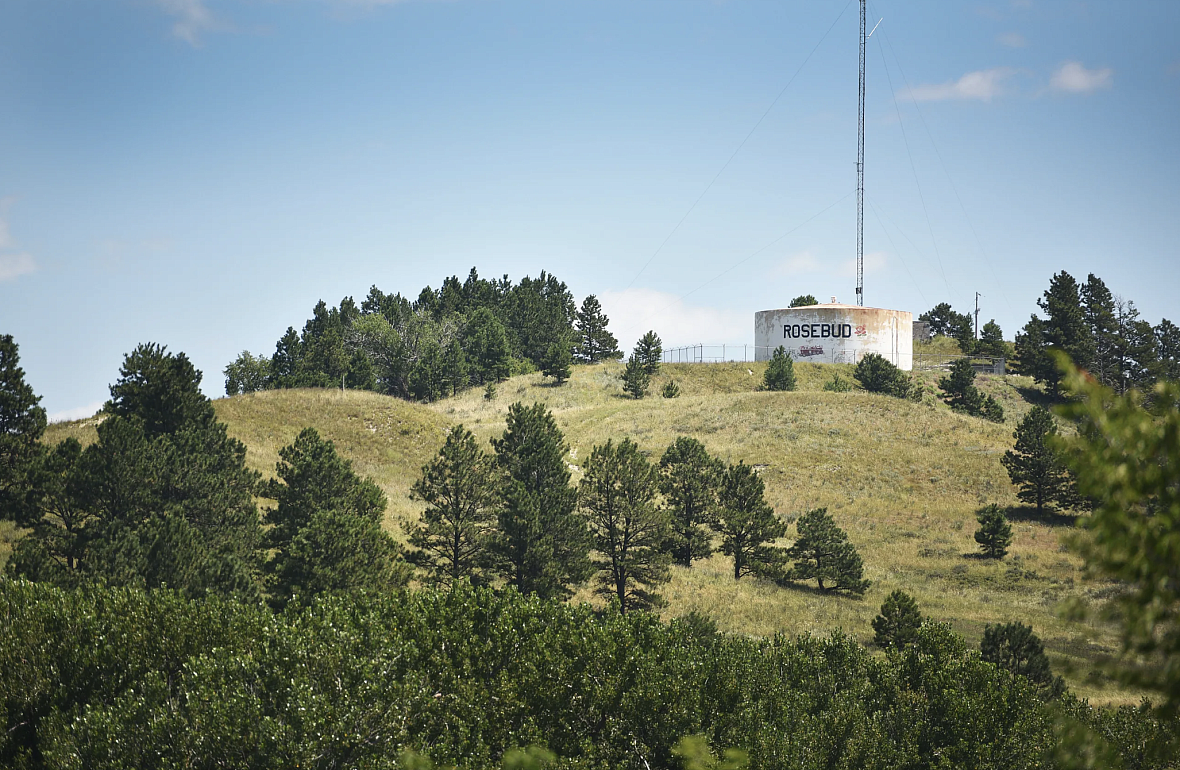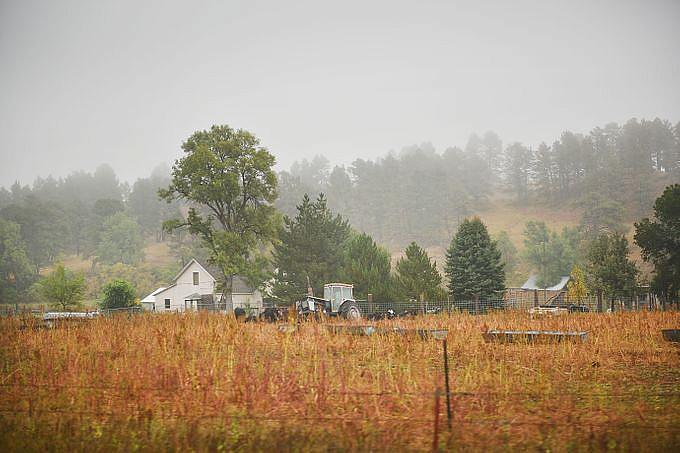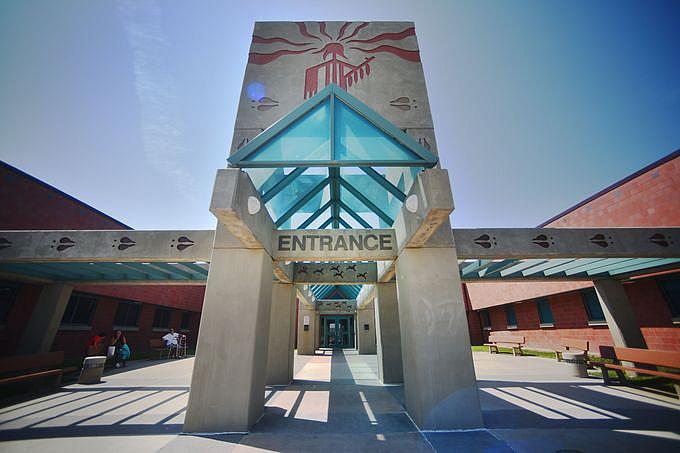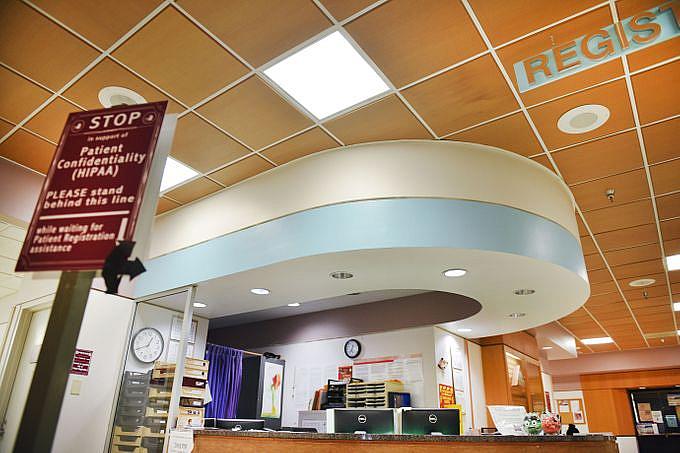Violated: How the Indian Health Service betrays patient trust and treaties in the Great Plains
Dana Marie Ferguson reported this story as a 2018 National Fellowship recipient.
Other stories in this series include:
Violated: Negligent care costs patients time, money and limbs at Indian Health Service hospitals
House committee demands answers from IHS, cites Argus Leader reporting
Violated: Inside South Dakota's Native American health care crisis

(Photo: Briana Sanchez/Argus Leader)
Dozens of patients have died needlessly due to errors made in Indian Health Service hospitals in South Dakota alone.
Doctors pulled Kathy Boyd’s heart out of her chest.
Hundreds of miles from her home on the Rosebud Indian Reservation, the 57-year-old wife and mother lay cut open on an operating table.
It never should have reached this point.
Doctors at the Rosebud Indian Health Service hospital neglected to act when they received an echocardiogram four years earlier that showed a valve in Kathy’s heart was struggling to pump blood.
Instead of giving the longtime IHS patient the treatment necessary to heal the faulty valve, they told her not to worry. The red flags warning of her failing heart were shoved in a drawer and ignored.
Kathy, a native South Dakotan and enrolled member in the Rosebud Sioux Tribe, wasn’t the first to experience this kind of dangerously deficient care from the federal agency charged with providing treatment to 2 million Native Americans across the country.
Dozens of patients have died needlessly due to errors made in IHS hospitals in South Dakota alone. Thousands more in the state’s rural Indian reservations face limited access to primary care providers, long wait times for basic medical treatments and outstanding medical debt for necessary care sought outside the federally-funded facilities.
The federal government has largely ignored the deplorable conditions. Even well-intentioned lawmakers representing states with significant Native American populations have failed to make meaningful change, including South Dakota’s Congressional delegation.
Meanwhile, the U.S. government remains in violation of its treaty promise to provide health care to Native Americans.
“We’re a third-world country, you know, a third-world country with our health care,” former Rosebud Sioux President William Kindle said in July, when he learned the Rosebud hospital was again at risk of losing federal funding.
Over the course of a monthslong investigation, the Argus Leader reviewed hundreds of pages of federal hospital inspection records and legal filings that illustrated the horror stories at two South Dakota IHS hospitals. The results are staggering:
- A 12-year-old girl attempted to hang herself after she was left alone in the Rosebud emergency room using her broken call light cord and her shoelaces.
- Doctors in the Rosebud emergency room restrained and pepper sprayed a man overdosing on meth, which caused a fatal heart attack.
- Faulty temperature controls and mold growing on the Rosebud hospital’s walls made patients and hospital employees sick, at times preventing hospital staff from working.
- Patients were put at risk of contracting disease when hospital staff failed to properly disinfect a blood sugar monitor between blood draws.
- Patients reported opting not to go to IHS hospitals out of fear of misdiagnosis. They said they'd rather take their chances with illness or injury at home.
Inspection records combined with dozens of patient interviews reveal medical failures at the hospitals that have persisted for years, despite warnings from federal watchdogs.
Promises to improve care at the hospitals never came to fruition. Attempts to sue the government for violating its treaty requirement to offer health care to enrolled tribal members have fallen short or stalled in court.
As Kathy laid on the operating table with her chest split open, the odds were against her.
A perfect storm in South Dakota
A perfect storm of state and federal policy failures, underfunding, geographic remoteness and extreme poverty on the Rosebud and Pine Ridge Indian Reservations create unique health care challenges IHS has tried in vain to overcome.
“Congress has been in breach of contract for decades,” said Donald Warne, chair of the Department of Public Health at North Dakota State University. “They have not fully funded IHS, and they know it.”
The hospitals have been underfunded from the start. When federal officials signed the Fort Laramie Treaty in 1868, they promised to provide health care to the tribes in exchange for land and natural resources for white settlers.
By the 1880s, promises were already broken. The Bureau of Indian Affairs experienced a “chronic shortage of doctors” and offered only limited services to patients, David H. DeJong, Native American policy expert, wrote.
In 1955, the responsibility to provide care for Native American people moved to the Indian Health Service, housed under the U.S. Department of Health and Human Services.
Over the last decade, Congress has repeatedly flagged the abominable conditions in the South Dakota facilities.
Late last year, the Pine Ridge IHS hospital lost its ability to bill to Medicare after it failed to meet the quality requirements for that program. The Rosebud IHS hospital faced a similar fate but made the improvements required to keep the funding stream late last month.
In recent months, IHS officials have set up new leadership teams in the hospitals and created procedures for reporting and correcting problems as they arise, Great Plains Area IHS Acting Director James Driving Hawk said.
“Those steps are in place now to really catch these things in advance,” Driving Hawk, an enrolled Rosebud Sioux tribal member, said in a phone interview Tuesday after months of requests for comment on the Argus Leader investigation. “We’re able to identify these things quicker.”
But tribal leaders question whether those improvements will stick.
Members of Congress echoed their concerns and vowed to bring legislation to fix long-standing problems at IHS. Despite bipartisan support, though, those efforts have flopped.
Most recently, a bill aimed at making it easier to fire problem doctors at IHS appeared poised to make it to the President’s desk. The bill had bipartisan support but lawmaker apathy stalled its progress.
And South Dakota lawmakers have refused to expand Medicaid, eliminating another funding source for the facilities. Of the 49,700 adults who would have received coverage under Medicaid expansion, 30 percent were Native Americans.
With Gov.-elect Kristi Noem set to take over the governor’s office in January, that option is off the table. The Republican congresswoman has said she would oppose expanding the federal health insurance program for needy people in South Dakota.
“I believe that’s a much more appropriate way to do it,” Noem said. “(We’ll) make sure that we’re providing services to those who need it in Medicaid but making sure that IHS is actually paying the bill for Native American folks instead of having Medicaid constantly pick up that bill.”
Isolation worsens IHS problems
The policy problems are exacerbated by the geographic isolation of the two hospitals. The facilities are in extremely remote, impoverished areas, making it difficult for the agency to recruit doctors to send there.
Housing on the reservations is limited. Safety is a concern, and schools there are some of the worst-performing in South Dakota.
The nearest Walmart is 130 miles away.
And while doctors may be interested in IHS jobs, their families aren't.
"The challenge we have is that we're not only recruiting an individual for a position," Driving Hawk said. "We're recruiting a family, and that's what our biggest challenge is to overcome."
Doctor turnover is high, which makes it hard for patients to see the same doctors consistently.
There is one primary care provider for every 9,960 people in Todd County, a county on the Rosebud Indian Reservation with a total population of just over 10,000. That’s a doctor-patient ratio eight times that of the state average in what is one of the poorest counties in the nation.


And patients who walk through the doors bring unique health challenges.
They lack consistent preventative care, live in areas considered food deserts and experience diabetes at the highest rates in the state.
Median life expectancy among Native American people in South Dakota is 23 years shorter than among white people and 21 years shorter than the state median, South Dakota Department of Health statistics show.
Other tribes have escaped similar situations by contracting with the federal government to take over their hospitals, cutting IHS out of the equation. Federal funds for the hospitals go straight to the tribes to run the hospital, and tribal leaders can disburse them as they see fit.
It’s an option that’s worked for the IHS hospital in Winnebago, Nebraska. In June, the Winnebago Tribe of Nebraska used the funds to take over control of their previously embattled facility. Now, tribal members and appointed medical experts decide how to spend the hospital’s money and who should be hired to work there.
But it’s not an option the Rosebud Sioux and Oglala Sioux tribes see as viable. Tribal leaders said the move lets the government evade its responsibility, and others said they don’t want to take on an endeavor that would be set up to fail.
“Why would we want to take over when it’s in the position it is now?” said Lydia Bear Killer, an Oglala Sioux health board member. “The tribe will fail. And I don’t think we want to do that.”
Watching the clock
Wayne Boyd paced the waiting room, counting the minutes since his wife went into surgery.
10. 20. 30. 40.
It’s not the first time he’d feared for a wife in her final moments.
Boyd’s first wife died of stomach cancer in 1987. For years she’d struggled with stomach pain, and it came to a head when she was pregnant.
When she went to IHS for answers, doctors told her she had a tumor. She had surgery to remove it, but doctors said the cancer had grown tentacles too entwined in her body to extract.
Wayne took her to chemotherapy treatments in Sioux Falls and cared for her at their home in Rosebud. Months later, she died, leaving Wayne a single father of six kids.
It was a painful transition to put the family’s life back together. But then Wayne met Kathy.
The two were married in 1989 and were eager to bring together their families. They’d hoped to have a baby together, but two years earlier Kathy received a diagnosis that would topple their plans.
A doctor at IHS told Kathy she had uterine cancer and said they’d have to perform a hysterectomy to avoid possible spread.
At 29, Kathy had the surgery.
A year later, she learned she’d been misdiagnosed. She likely didn’t need the hysterectomy.
The mistake cost Kathy and Wayne a child. And it made Kathy a skeptic of the agency required to provide her care.
She tried to prevent any possible mishaps after that.
In 2009, she drove an hour to Valentine, Nebraska to have doctors take an ultrasound of her heart. She was a smoker and had started to notice her heart feeling heavier in her chest.
The results were sent to the Rosebud IHS hospital, but Kathy never heard back about the test.
She called to ask about the echocardiogram, but no one could answer her. Someone there said no news was probably good news. She didn’t know that a doctor had shelved the results without flagging the clogged valve that would later put her life in peril.
Two years later, she went for another ultrasound in Valentine. Her heart felt like it was beating much faster than it should. Again, when she called Rosebud, they had no information about the test.
If they’d consulted the scan they would’ve seen her valve was defective and was struggling to pump blood.
It would take another four years for doctors to discover the valve issues. And by then, Kathy’s heart would be near failing.
Fighting for change
For decades, health advocates have fought to make things better at IHS.
Several have burned out when Congress failed to heed their concerns. Kathy’s daughter Evie Espinoza was one of them. Espinoza was convinced that things would get better in 2016.
After she watched her biological mother die she decided to pursue a career in nursing. She became the Rosebud Sioux Tribe’s health administrator and was in that role in 2016 when the Centers for Medicare and Medicaid Service – another agency under the Department of Health and Human Services that inspects hospitals and determines if they can accept federal health insurance – threatened to pull key funding from the Rosebud hospital if it couldn’t improve the quality of care.
In 2015, federal inspectors found a baby was born on the bathroom floor unattended. Surgical instruments were hand washed, and limbs were amputated unnecessarily. Hospital staff didn’t take steps to prevent the spread of tuberculosis among patients.
The hospital shut down its emergency room to deal with problems and kept it closed for seven months.
During that time, patients were rushed to the nearest hospital 45 miles away, and several died in the backs of ambulances.
The hospital’s failures made national headlines, and Espinoza was convinced this would be rock bottom. It could only get better from there, she said.
She met with the then-acting IHS Director Mary Smith, who came to hold listening sessions in South Dakota. She rallied support for legislation that could help attract more doctors and make it easier to fire IHS doctors that broke hospital rules or delivered negligent care.
But when those efforts fell short, Espinoza had to quit. It became too much for her to handle.
“We're talking about entire communities being destroyed. We are talking about families being affected for generations,” she told the Senate Committee on Indian Affairs in 2016. “It's almost like we have to prove these awful things are happening, when they're documented things happening … You feel helpless. It's like hopeless. You get stuck in this, the sense of gloom, like it's never going to change.”
An ER visit gone wrong
It was a warm April night in 2015 when Kathy felt her heart beating too fast.
She’d been enjoying a cigarette and looking out into the forest of pine behind her home when she knew something was wrong.
Normally washing the dishes was enough to slow her heart when it beat too quickly, but on that night, it kept speeding up.
Wayne drove Kathy to the ER in Rosebud. Around 7 p.m. they told a nurse that Kathy had chest pain and trouble breathing, hospital records show.
The nurse noted that Kathy’s heart rate was abnormally fast and triaged her in the second-most serious category.
Hospital inspection records show that, with her symptoms, Kathy should’ve been in the most serious category, which calls for immediate care for life-threatening conditions.

Instead, she waited an hour to see a doctor while her heart was failing.
The doctor checked Kathy’s heart rate on the monitor and gave her a medication to slow the beating. When her heart rate came down, he said Kathy could go home and return to the clinic the next day.
Both a nurse and Espinoza intervened, saying Kathy wasn’t stable enough to leave. They asked the doctor to send Kathy to a heart hospital in Sioux Falls or Rapid City for care.
The doctor agreed but didn’t act. Medical records show he called a Sioux Falls cardiologist but never requested a transfer for the more than 200-mile trip.
At 9 p.m., two hours after Kathy reached the ER, the doctor scheduled a transfer to Rapid City, 160 miles away. But tribal ambulance team said they couldn’t take her.
Another two hours later, an air flight team took Kathy to Rapid City, her last hope.
The next day, her heart was outside her body, and she was lying on a table with her life in the balance.
Living with the scar
An eight-inch scar runs down the center of Kathy’s chest today.
With her index finger, she traced the line where doctors cut open her chest. Her artificial valve makes a distinct sound. One her heart didn’t make before.
“You can hear me ticking,” she said, “like water dripping.”
It’s one of the lasting marks IHS has left on her life. But it’s not the only one.
Nearly every aspect of Kathy’s life has changed since the surgery.
“Emotionally, I will never be the same,” she said, tearing up. “I try to be strong, but it’s really hard.”
She’s more delicate now than she was before. A small cut in her mouth or paper cut on her finger could pose more danger since her blood has been artificially thinned.
“If I’m ever in a major car accident, I will die before I get to the hospital,” she said. “I can’t lose that kind of blood.”
Wayne worries about how he shows her affection.
“It’s changed everything,” he said. “I don’t want to hug her too tight.”
The couple’s finances are also in disarray. While her private insurance helped to cover the surgery, it wouldn’t pay the $53,000 bill for the flight to Rapid City.
File boxes of medical bills line the cedar-planked wall behind her desk at Sinte Gleska University.
The financial stress has forced her family to put off patching a hole in their living room blown open during a rainstorm. And Kathy has started a catering job in addition to her day job to make ends meet.
She’s also had trouble connecting to her spirit since the surgery.
Once an avid participant in sweat lodge and sun dance ceremonies, Kathy said she’s lost a part of herself. The ceremonies used to help her connect to her spirit and to her relatives.
With the help of a medicine man Kathy attempted to bring back her spirit after her heart was taken out.
Just a fraction of it came back to her body, she said.
“I can pray, and God’s still going to listen to me, but I can’t sweat lodge. I can’t go to sun dances,” she said. “I don’t feel like Kathy. I don’t feel like me. I’m just not who I used to be."
“I’m different, and it’s because of IHS’ negligence.”
But Kathy also knows she’s one of the lucky ones. At least her heart is still beating.
[This story was originally published by Argus Leader. A shorter version of it also ran in USA Today.]

